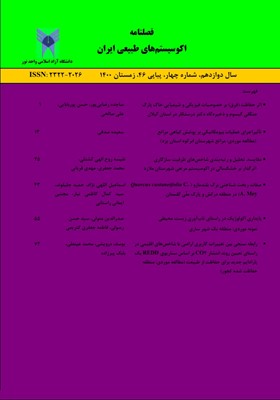رابطه سنجی بین تغییرات کاربری اراضی با شاخصهای اقلیمی در راستای تعیین روند انتشار CO2 بر اساس سناریوی REDD یک پارادایم جدید برای حفاظت از طبیعت (مطالعه موردی: منطقه حفاظت شده کجور)
محورهای موضوعی : تغییرات اقلیمی و اکوسیستم ها
کلید واژه:
چکیده مقاله :
تغییر کاربری اراضی اغلب بدون رعایت اصول و محدودیت های زیستمحیطی صورت می گیرد و تبعاتی همچون جنگل زدایی را به دنبال خواهد داشت،کسب اطـلاعات دقیق از پتانسیل های کاربری اراضی امری ضروری است. هدف اصلی این سناریو در واقع کاهش گاز های گلخانه ای (متان،دی اکسید کربن و دی اکسید نیتروژن) و افزایش ترسیب کربن در منطقه ای با تغییرات شدید کاربری اراضی است. لذا در این پژوهش بر ضرورت ایجاد و تداوم یک نهضت آموزشی با هدف تغییر رفتار و اصلاح بینش عمومی نسبت به محیطزیست و تغییرات اقلیمی، برای دستیابی به توسعه پایدار تاکید شده است. در تحقیق حاضر از تصاویر ماهواره لندست در 7 دوره زمانی استفاده شد. به منظور بررسی و تحلیل تغییرات پوشش گیاهی در منطقه مورد مطالعه از شاخص های EVI,DVI و NDVI استفاده گردید، این شاخص ها از پردازش تصاویر ماهواره های لندست 5، 4 و 8 که به صورت محصول سنجش از دور در دسترس است در بازه زمانی 1985، 1990، 1995 ، 2000، 2010، 2015 و 2017 با استفاده از پردازنده گوگل ارث انجین استخراج شدند. در همین راستا اجرای مدل سازی پتانسیل انتقال با الگوریتم رویه یادگیری بر مبنای پرسپترون چند لایه و پیش بینی تغییرات برای بهترین مدل با استفاده از زنجیره مارکف انجام شد. سپس برای ارزیابی صحت مدل سازی با آماره های Hit، Misses و False alarm استفاده گردید. در پایان بر طبق روش (BioCF) BioCarbon Fund و دوره پایه 1364-1396 مدلسازی تغییرات پوشش جنگل برای ٣٠ سال آینده (تا سال 1426) صورت گرفت و میزان انتشار Carbon Stock تا سال 1426 محاسبه گردید. نتایج تحلیل همبستگی نشان داد که همبستگی مکانی معنی داری بین دینامیک پوشش گیاهی با بارندگی وجود داشته که در ماه های زمستان، این ارتباط معنی دار و مستقیم و در تابستان معکوس بوده است. بین سال های 1396 تا 1426 در صورت عدم اجرای استراتژی پروژه حدود 199569 هکتار پوشش جنگل تخریب میشود و 1995695 تن دی اکسید کربن انتشار می یابد که در صورت اجرای پروژه REDD این میزان انتشار به 405512 تن دی اکسید کربن میرسد که می توان از انتشار 1590183 تن دی اکسید کربن به جو فوقانی زمین جلوگیری نمود. جهت جلوگیری از گسترش بی رویه مناطق مسکونی و تخریب عرصه های جنگلی و پوشش گیاهی باید اقدامات مدیریتی انجام شود و تصمیمات مدیریتی اتخاذ گردد زیرا مقدار سطح جنگلهای متراکم و نیمه متراکم در مناطق با شیب زیاد تا سال 1426 کاهش بیشتری می یابد.
Land use change often takes place without observing the principles and restrictions of the environment and will have consequences such as deforestation, obtaining accurate information about land use potentials is essential. The main purpose of this scenario is to reduce greenhouse gases (methane, carbon dioxide and nitrogen dioxide) and increase carbon sequestration in areas with severe land use change. Therefore, in this study, the need to create and continue an educational movement with the aim of changing behavior and improving public perceptions of the environment and climate change, to achieve sustainable development has been emphasized. In the present study, Landsat satellite images were used in 7 time periods. In order to study and analyze vegetation changes in the study area, EVI, DVI and NDVI indices were used. These indices are from the image processing of Landsat 5, 4 and 8 satellites, which is available as a remote sensing product. The engine was extracted between 1985, 1990, 1995, 2000, 2010, 2015 and 2017 using the Google Earth processor. In this regard, the transfer potential modeling was performed with a learning procedure algorithm based on multilayer perceptron and prediction of changes for the best model was performed using Markov chain. Then it was used to evaluate the accuracy of modeling with Hit, Misses and False alarm statistics. Finally, according to the BioCF method and the basic period of 1364-1396, modeling of forest cover changes for the next 4 years (until 1426) was modeled and the amount of Carbon Stock emission until 1426 was calculated. The results of correlation analysis showed that there was a significant spatial correlation between vegetation dynamics and rainfall, which was significant and direct in winter and inverse in summer. Between 1396 and 1426, if the project strategy is not implemented, about 199569 hectares of forest cover will be destroyed and 1995695 tons of carbon dioxide will be emitted. Prevented the release of 1590,183 tons of carbon dioxide into the Earth's upper atmosphere. In order to prevent the uncontrolled expansion of residential areas and the destruction of forest areas and vegetation, management measures should be taken and management decisions should be made, because the amount of dense and semi-dense forests in areas with high slopes will be further reduced by 1426.
_||_

